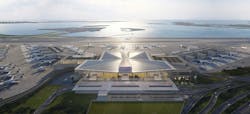How JFK's New Terminal One Reimagines the Passenger Experience
What You'll Learn in this Article

-
How JFK’s New Terminal One rethinks curbside and terminal design to streamline traffic flow and reduce passenger friction from arrival to departure.
-
The role of early collaboration between operations and architecture teams in building a flexible, common-use terminal designed for real-world performance.
-
Ways the terminal incorporates emerging technologies like biometrics, CTX scanners and electric ground support equipment to support future operations and sustainability goals.
-
How stakeholder coordination and traveler feedback are being used to inform the design, execution and long-term adaptability of the terminal.
When the first gates of John F. Kennedy International Airport's New Terminal One open in summer 2026, travelers will enter a facility shaped by years of planning, design and collaboration. Spanning 2.6 million square feet and developed through a public-private partnership with the Port Authority of New York and New Jersey, the $9.5 billion terminal is part of a broader effort to modernize JFK. While the facility reflects a major capital upgrade, it also aims to integrate improved passenger flow, flexible operations and emerging technologies in one of the country’s busiest international gateways.
"From the moment you approach the curb, the experience is designed to feel seamless," said Marisa Von Wieding, vice president of operations for New Terminal One. "We worked closely with our architects, stakeholders and operations teams to make sure every touchpoint considered the needs of the traveler first."
Operations Focused Design
The terminal’s curbside areas were developed with input from airport operations and architecture teams to reduce congestion and clarify traffic flow. The design includes two tiers for pick-up and drop-off activities. Dynamic signage and real-time data from LIDAR sensors and license plate recognition software will help manage the flow of vehicles, which include taxis, ride-hailing services, buses and private cars.
A "sawtooth" parking layout for ride-share zones allows vehicles to pull in and out without reversing, which the operations team expects will reduce wait times and traffic backups. The separation of passenger categories—such as those requiring special assistance—was also built into the layout.
Airport operations teams were engaged in early phases of design to ensure the terminal would function efficiently during both routine and irregular operations. The layout includes common-use gates, ticket counters and baggage makeup areas, allowing real-time reassignment based on demand.
"It’s one thing to draw a beautiful terminal. It’s another to operate it efficiently," Von Wieding said. "We made sure that flexibility and common-use operations were built in."
Technology infrastructure supports operational adaptability, and the terminal’s digital systems are designed to allow for future system upgrades. The project team expects this flexibility to be critical as passenger needs and technologies evolve.
Terminal planners placed a strong emphasis on reducing friction in areas historically associated with passenger stress, including security and immigration. Von Wieding said the design team worked closely with the Transportation Security Administration (TSA) to install the latest equipment and to ensure the checkpoint layout would support passenger throughput.
The checkpoint area includes wider spacing, newer CTX scanners and biometric identity verification technologies. Similar measures are being coordinated with U.S. Customs and Border Protection (CBP) for the arrivals hall. Because the terminal will serve only international flights, CBP will be able to use biometric galleries based on passport data to expedite identity matching and processing.
Traveler Experience by Design
The design team used journey mapping to study how different types of travelers use the airport. Johnson said the team examined the needs of business travelers, families, travelers with limited mobility and other groups to shape a more adaptable terminal experience.
The result includes dedicated check-in areas for passengers requiring assistance, quiet and sensory rooms, adult changing facilities, multilingual signage and clear sightlines to gates. Natural light and high ceilings were used throughout the facility to support wayfinding and reduce stress.
"Wayfinding should be felt, not forced," said Matthew Johnson, a principal at Gensler and the project’s lead architect. "That’s why architectural cues like linear skylights and strategic canopies guide passengers naturally through the space."
Flexibility was a major theme across the terminal’s design and development. The facility includes contractual provisions that allow its digital and operational systems to evolve, and teams have access to a dedicated test environment for evaluating new technologies.
One example is the use of electric ground support equipment (GSE). The terminal is expected to be the first globally to open with 100% electric GSE supported by a pooled equipment model. According to Von Wieding, the approach supports sustainability goals while also introducing a scalable model for ramp operations.
To measure performance, the terminal will use intercept surveys, social media analysis and wait-time monitoring through LIDAR systems. These tools are intended to support responsive operations and inform future adjustments.
Coordinated Execution
Multiple stakeholder groups, including the Port Authority, TSA, CBP and airline tenants, were part of the project’s planning process. Von Wieding said operational and design teams held regular meetings to review layouts, evaluate service needs and prepare for future scenarios.
"We wanted buy-in, not just sign-off," Von Wieding said. "We even let the airlines participate in some procurement evaluations because it’s ultimately their passengers we’re serving."
According to Johnson, the design team aligned passenger experience goals with commercial and operational requirements. "We designed to maximize throughput and commercial opportunity, but none of it works if the human experience isn’t central," he said.
The terminal’s success will be measured through a mix of operational data, sustainability benchmarks and traveler feedback. Performance indicators include customer satisfaction surveys, wait times, processing efficiency, social media sentiment and Skytrax ratings. Additional evaluations will track energy use, solar panel output and accessibility outcomes.
With Phase A expected to open in 2026 and additional phases continuing through 2030, the project offers a long-term framework for how JFK and its partners aim to respond to shifting travel behaviors, new technologies and global demands on airport infrastructure.
About the Author
Joe Petrie
Editor & Chief
Joe Petrie is the Editorial Director for the Endeavor Aviation Group.
Joe has spent the past 20 years writing about the most cutting-edge topics related to transportation and policy in a variety of sectors with an emphasis on transportation issues for the past 15 years.
Contact: Joe Petrie
Editor & Chief | Airport Business
+1-920-568-8399
>> To download the AviationPros media kits, visit: Marketing Resource Center
>>Check out our aviation magazines: Ground Support Worldwide | Airport Business | Aircraft Maintenance Technology
